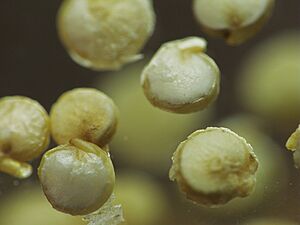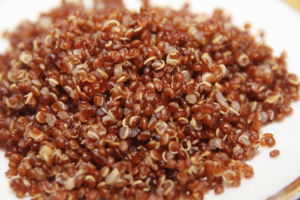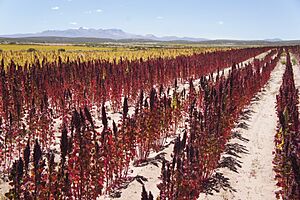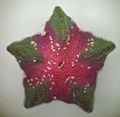Quinoa facts for kids
Quick facts for kids Quinoa |
|
|---|---|
 |
|
| Scientific classification | |
| Genus: |
Chenopodium
|
| Species: |
quinoa
|
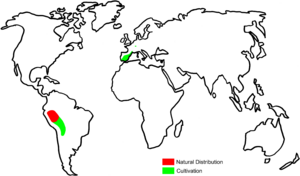 |
|
| Natural distribution in red, Cultivation in green | |
| Synonyms | |
|
|
Quinoa (pronounced KEEN-wah) (Chenopodium quinoa) is a cool flowering plant. It belongs to the amaranth family, just like spinach! Even though we eat its seeds like a grain, it's not a true grass. That's why it's called a "pseudocereal" (SOO-doh-seer-ee-uhl), which means "false cereal." People grow quinoa mostly for its tiny, edible seeds. These seeds are super healthy! They are full of protein, fiber, B vitamins, and important minerals like potassium and magnesium.
Quinoa first grew in the Andes Mountains in South America. People there started using it to feed animals about 5,200 to 7,000 years ago. Then, about 3,000 to 4,000 years ago, people in Peru and Bolivia began eating it too.
This amazing plant loves growing high up in the mountains. Today, most quinoa from the Andes is grown by small farms. But it has become so popular that over 70 countries now grow it. These include Kenya, India, the United States, and countries in Europe. Because so many people in places like North America and Europe started eating quinoa, its price went up a lot between 2006 and 2014.
Sometimes, when a crop gets very popular, farmers plant only that one crop. This is called monoculture. For quinoa, this, along with weather changes in the Andes, has made it harder to grow. It has also sometimes been tough on the environment.
Contents
What Does Quinoa Look Like?
The quinoa plant (Chenopodium quinoa) is an annual plant. This means it grows and produces seeds in just one year. It usually grows to be about 1 to 2 meters (3 to 6.5 feet) tall. Imagine a plant a bit taller than you!
It has wide, somewhat fuzzy leaves that can look a bit powdery. These leaves grow one at a time along the stem. The main stem is woody and can be green, red, or even purple. This depends on the type of quinoa. Some quinoa plants have many branches, while others have just one main stem.
The flowers grow in clusters called panicles at the top of the plant. The flowers themselves are tiny. Quinoa plants can usually pollinate themselves. Sometimes, pollen from other quinoa plants helps too. Colorful pigments in the plant help attract animals. These animals can help spread pollen or seeds.
After flowering, the plant produces its fruits, which are the seeds we eat! These seeds are tiny, only about 2 millimeters (1/16 of an inch) across. They can be white, red, or black, depending on the specific type of quinoa.
Some types of quinoa can even grow in salty soil. Scientists think the plant can build up special substances to deal with the salt. It might also close tiny pores on its leaves to save water when the soil is salty.
Quinoa's History and Name
Carl Ludwig Willdenow, a German plant scientist, was the first to officially describe quinoa. He learned about it from plants brought back from South America by explorers.
Where Did Quinoa Come From?
Quinoa is a special plant because it has extra sets of chromosomes. It's like it got a double dose of instructions from two different parent plants! Scientists think its ancient relatives might be plants like Chenopodium berlandieri from North America.
Over time, quinoa has changed a lot:
- A New Plant: When its two ancient parent plants combined, the new quinoa plant was different. It couldn't mix back with them, so it started with less variety.
- Becoming a Crop: When people started farming quinoa, they chose specific types to grow. This likely happened in two different places: the high Andes mountains and the lower lands of Chile and Argentina.
- A Tough Time: For over 400 years, after Europeans arrived in South America, quinoa became less popular. Other crops like maize (corn) were grown more. This was partly because quinoa was important to local traditions.
- Modern Challenges: Today, as more farmers move to cities, some old, diverse types of quinoa could disappear. However, scientists are also creating new types.
What's in the Name?
The first part of its scientific name, Chenopodium, comes from Greek words. Chen means "goose" and podion means "little foot." This is because the leaves of some plants in this group look a bit like a goose's footprint!
The word "quinoa" comes from the Spanish word quinua or quinoa. The Spanish got this word from the Quechua language spoken in the Andes. In Quechua, it's called kinuwa.
The Inca people, who lived in the Andes long ago, had a special name for quinoa: chisiya mama. In their language, this means "mother of all grains." This shows how important quinoa was to them!
Where Does Quinoa Grow?
Scientists believe that people first started farming quinoa in the Andes Mountains of Peru. They likely chose the best plants from wild quinoa already growing there. Even today, you can find wilder types of quinoa growing near farmed fields.
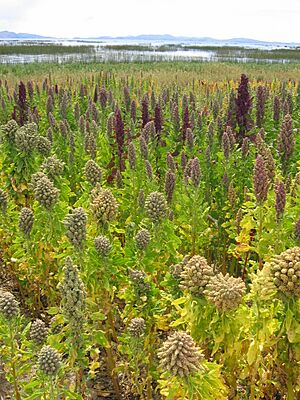
How People Grow Quinoa
For the last 5,000 years, where and how quinoa grows has changed a lot. It's not just grown in more places, but it can also now grow in different climates.
Long ago, people in South America, especially in Chile, helped quinoa adapt to grow in salty soil. This happened over 3,000 years! Quinoa was also grown near the coast of northern Chile by ancient people. From the high Andes, quinoa was brought to the lower areas of south-central Chile. People in Chile even used to make bread from quinoa!
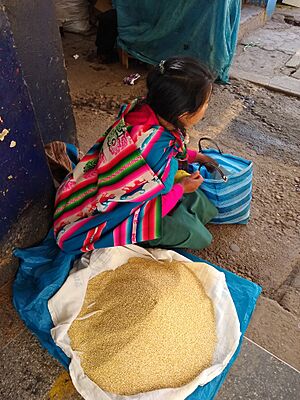
By the 1940s, quinoa almost disappeared in Chile. But now, small groups of farmers are growing it again. Some are Indigenous growers, others are farmers in central Chile, and some are women growing it in home gardens.
Scientists studying ancient pollen found that quinoa became a popular crop in areas of the Andes. It was farmed in different places, which led to different types of quinoa developing. This variety shows how important quinoa has always been.
In the early 2000s, people around the world became very interested in quinoa. Between 2004 and 2011, more and more people wanted it. At first, Bolivia and Peru were the main countries growing it. By 2013, countries like the United States, Canada, and many in Europe were buying a lot of quinoa. But by 2016, as more countries started growing their own quinoa, prices went down. In the 1980s, only about eight countries grew quinoa, but by 2015, over 75 countries were growing it!
What Kind of Weather Does Quinoa Need?
Quinoa is a tough plant! It can grow in many different conditions because there are so many types. It's usually grown high up in the Andes, from coastal areas to over 4,000 meters (13,000 feet) high. Most types grow best between 2,500 and 4,000 meters (8,200 to 13,000 feet).
Quinoa likes cool weather. Ideal temperatures are between -4°C (25°F) at night and up to 35°C (95°F) during the day. Some types can even handle colder temperatures. A light frost usually doesn't hurt the plants, unless it happens when they are flowering. Frost during flowering can stop the plant from making seeds. How much rain quinoa needs varies a lot, from 300 to 1,000 millimeters (12 to 39 inches) while it's growing. It's best if it rains steadily when the plant is young and then stays dry when the seeds are ready to be picked.
Growing Quinoa in the United States
People have been growing quinoa in the United States since 1983. A high-altitude area in Colorado called the San Luis Valley is one place. Here, summer days rarely get hotter than 30°C (86°F), and nights are cool. More recently, farmers in Washington state have started growing quinoa. The climate there is similar to coastal Chile. Farmers in North America need types of quinoa that ripen quickly. Quinoa is also grown in Idaho, using a special variety.
Growing Quinoa in Europe
Several European countries, like southern England, Holland, and Denmark, are now successfully growing quinoa too.
Planting the Seeds
Quinoa seeds need a good amount of rain to start growing. So, in Peru, farmers traditionally plant them between September and November. To make sure more plants survive, they might plant seeds at different times. The soil needs to be prepared before planting, and weeds need to be removed soon after.
Farmers in the Andes often use crop rotation. This means they plant different crops in the same field in different years, like potatoes, cereals, and legumes (like beans). This helps keep the soil healthy.
What Kind of Soil is Best?
Quinoa plants grow best in sandy soil that drains well. The soil shouldn't have too many nutrients. It can be a bit salty, and should have a pH level (how acidic or alkaline the soil is) between 6 and 8.5. It's important that the seedbed drains well so the plants don't get waterlogged. Quinoa is amazing because it can grow in tough places, like salty soils, soils with few nutrients, and dry areas.
Quinoa's Genes
Scientists figured out all the genetic information of quinoa in 2017. This is like having its complete instruction manual! Using this information, scientists are trying to create quinoa types that:
- Produce more seeds (higher yield)
- Can handle heat and plant diseases better
- Taste sweeter because they have less of a natural bitter coating called saponin
Getting the Seeds: Harvesting
Traditionally, people harvest quinoa by hand. It's rare to use machines because different quinoa plants, and even different parts of the same plant, get ripe at different times. If you harvest too early or too late, you can lose a lot of seeds. The amount of quinoa harvested in the Andes is similar to wheat harvests. In the United States, farmers use special varieties that ripen all at once. This way, they can use machines like those used for wheat.
Getting the Seeds Ready: Processing
After harvesting, the plants are left to dry until the stalks and seeds are dry enough. Then, the seed heads are threshed to separate the seeds from the rest of the plant parts. The seeds are then winnowed to remove the outer husk. Before storing, the seeds must be dried completely. This used to be all done by hand, which was a lot of work!
Who Grows the Most Quinoa?
| Quinoa production – 2023 | |
|---|---|
| Country | Tonnes |
| 70,479 | |
| 41,380 | |
| 378 | |
| World | 112,251 |
| Source: FAOSTAT of the United Nations | |
In 2023, the world grew 112,251 tonnes of quinoa. A tonne is 1,000 kilograms, which is about the weight of a small car! Peru was the biggest producer, growing 62% of all the quinoa. Bolivia was second, growing 37%.
How Much Does Quinoa Cost?
When quinoa became popular in places like North America and Europe, its price went up a lot. Between 2006 and 2013, the price for quinoa tripled! In 2011, one tonne of quinoa cost about US$3,115 on average. Some special types even sold for $8,000 per tonne! That's much more than wheat, which cost only about $340 per tonne back then.
Because quinoa was so valuable, more countries started growing it. By 2013, about 70 countries were farming quinoa. But when so many places started growing it, the price dropped a lot in early 2015. This big drop in price was hard for many farmers, especially in Peru and Bolivia. Some people called it the "quinoa bust."
How Did Quinoa's Popularity Affect Farmers?

When quinoa prices went up, it sometimes made it harder for people in the Andes to afford it. However, studies showed that many quinoa farmers, especially in Peru, actually earned more money during this time.
An interesting thing happened too. Some farmers who started earning more money began to eat more processed foods (like snacks from a package). This might be because quinoa became too valuable to eat themselves. To help with this, some places are working to make sure local people can still get quinoa. This includes giving it out in school breakfast programs.
The quinoa boom had different effects on different farmers in Bolivia. Some benefited by working together in groups. For some, it meant they could grow quinoa to sell (as a cash crop). Others focused on growing it for their own families (subsistence farming).
The huge demand for quinoa also raised some worries. Could local people still get enough to eat? Was farming harming the environment? Studies have shown that traditional, small-scale quinoa farming in the Andes is often better for the environment than large, industrial farming.
Farming Only Quinoa and Weather Changes
Because so many people wanted quinoa, some farmers in Bolivia and Peru started planting only quinoa. This is called monoculture. In places like the Uyuni salt flats, using machines for quinoa fields has sometimes damaged the soil. This can mean farmers get less quinoa, and it's not good for the local environment.
Changes in the Earth's climate are also making things harder. Drier and hotter weather is bad for quinoa. It can also mean more pests that attack the plants and poorer soil. This can lead to desertification, where good land turns into desert.
Quinoa is known for being able to grow in tough weather. The Andes, where it comes from, can have very dry or very wet times. Scientists have found that quinoa actually likes warmer weather and getting watered on and off. But because climate change is making weather more unpredictable, it's becoming harder to grow quinoa successfully.
When quinoa was super popular, farmers in the Andes grew more of it. But then, other countries like the U.S. and some in Europe started growing it too. Some studies suggest that it might be easier to grow lots of quinoa in places like Washington State in the U.S., or in China.
| Nutritional value per 100 g (3.5 oz) | |
|---|---|
| Energy | 1,539 kJ (368 kcal) |
|
64.2 g
|
|
| Dietary fibre | 7.0 g |
|
6.1 g
|
|
| Monounsaturated | 1.6 g |
| Polyunsaturated | 3.3 g |
|
Protein
|
14.1 g
|
| Vitamins | Quantity
%DV†
|
| Vitamin A equiv. |
0%
1 μg |
| Thiamine (B1) |
31%
0.36 mg |
| Riboflavin (B2) |
27%
0.32 mg |
| Niacin (B3) |
10%
1.52 mg |
| Vitamin B6 |
38%
0.49 mg |
| Folate (B9) |
46%
184 μg |
| Choline |
14%
70 mg |
| Vitamin C |
0%
0 mg |
| Vitamin E |
16%
2.4 mg |
| Minerals | Quantity
%DV†
|
| Calcium |
5%
47 mg |
| Copper |
30%
0.590 mg |
| Iron |
35%
4.6 mg |
| Magnesium |
55%
197 mg |
| Manganese |
95%
2.0 mg |
| Phosphorus |
65%
457 mg |
| Potassium |
19%
563 mg |
| Selenium |
12%
8.5 μg |
| Sodium |
0%
5 mg |
| Zinc |
33%
3.1 mg |
| Other constituents | Quantity |
| Water | 13.3 g |
|
Link to USDA Database entry
|
|
| †Percentages estimated using US recommendations for adults. | |
The Science of Quinoa Seeds
Quinoa seeds naturally have a coating on them that contains saponins. Saponins taste bitter, which makes the raw seeds not very nice to eat. Most quinoa you buy in stores has had this coating removed. This bitter coating is actually helpful when quinoa is growing! It keeps birds away, so the plants don't need as much protection. Scientists are trying to breed quinoa that has less saponin so it tastes sweeter naturally. This is tricky because quinoa plants can cross-pollinate (mix their pollen). They might even use genetic engineering (changing the plant's genes) to do this.
Saponins are generally considered mild irritants if they get in your eyes or if you breathe them in. They can also mildly upset your stomach. But in South America, people have traditionally used these saponins for many things! They can be used like soap for washing clothes, and as an antiseptic (something that kills germs) for skin injuries.
Also, the leaves and stems of quinoa plants contain something called oxalic acid.
Why People Eat Quinoa
More and more people are eating quinoa because it's seen as a food that can help make sure everyone has enough to eat (food security). It's packed with protein, so it's a great choice for vegetarians, vegans, and people who can't have dairy. Quinoa also has lots of healthy minerals and it's gluten-free (safe for people who can't eat wheat). These good qualities made it popular, especially with people in North America.
Quinoa has always been a very important food for the Indigenous people of the Andean Altiplano (high plains). For them, it was a basic food that helped them survive. When the Spanish came to South America, they didn't value quinoa as much. They saw that local people ate it every day and used it in special ceremonies. The Spanish tried to stop people from growing quinoa, and for a while, much less of it was grown.
For the Indigenous communities, growing quinoa meant they had food and could live well. It was part of almost every meal!
What Makes Quinoa Healthy?
| Nutritional value per 100 g (3.5 oz) | |
|---|---|
| Energy | 503 kJ (120 kcal) |
|
21.3 g
|
|
| Dietary fibre | 2.8 g |
|
1.92 g
|
|
| Monounsaturated | 0.529 g |
| Polyunsaturated | 1.078 g |
|
Protein
|
4.4 g
|
| Vitamins | Quantity
%DV†
|
| Vitamin A equiv. |
0%
0 μg |
| Thiamine (B1) |
9%
0.107 mg |
| Riboflavin (B2) |
9%
0.11 mg |
| Niacin (B3) |
3%
0.412 mg |
| Vitamin B6 |
9%
0.123 mg |
| Folate (B9) |
11%
42 μg |
| Choline |
5%
23 mg |
| Vitamin C |
0%
0 mg |
| Vitamin E |
4%
0.63 mg |
| Minerals | Quantity
%DV†
|
| Calcium |
2%
17 mg |
| Copper |
10%
0.192 mg |
| Iron |
11%
1.49 mg |
| Magnesium |
18%
64 mg |
| Manganese |
30%
0.631 mg |
| Phosphorus |
22%
152 mg |
| Potassium |
6%
172 mg |
| Selenium |
4%
2.8 μg |
| Sodium |
0%
7 mg |
| Zinc |
11%
1.09 mg |
| Other constituents | Quantity |
| Water | 72 g |
|
Link to USDA Database entry
|
|
| †Percentages estimated using US recommendations for adults. | |
When quinoa is raw (uncooked), it's mostly carbohydrates (64%). It has a good amount of protein (14%), some fat (6%), and water (13%). A 100-gram serving of raw quinoa seeds is packed with food energy. It's a great source of protein, fiber, several B vitamins (especially folate), and important minerals like magnesium, manganese, phosphorus, and zinc.
Most people eat quinoa after boiling it. When cooked, quinoa has a lot more water (72%). This means that in the same 100-gram serving, the amounts of carbohydrates (21%), protein (4%), and fat (2%) are lower. Cooked quinoa also has less food energy. Even though the amounts are lower, cooked quinoa is still a good source of minerals like manganese and phosphorus. It also gives you some fiber, folate, iron, magnesium, and zinc.
A big plus is that quinoa is gluten-free! This means people who can't eat gluten (found in wheat, barley, and rye) can enjoy quinoa. Because quinoa is so nutritious and easy to prepare, NASA has even chosen it as a food to study for astronauts on long space flights!
Quinoa in Culture
A Special Year for Quinoa
The United Nations (an organization of countries working together) declared 2013 as the "International Year of Quinoa." They did this to honor the ancient ways the Andean people have grown and used quinoa for thousands of years. These people have kept quinoa as a food for everyone by living in harmony with nature. The goal of this special year was to show the world how quinoa could help with food security (making sure everyone has food), nutrition (eating healthy), and reducing poverty.
Is Quinoa Kosher for Passover?
In the Jewish faith, during the holiday of Passover, people don't eat certain grains. Some Jewish people use quinoa as a substitute for these grains. For a while, some kosher groups (organizations that check if food meets Jewish dietary laws) didn't want to say quinoa was kosher for Passover. They worried it looked too much like the forbidden grains. But in December 2013, the Orthodox Union, a very large kosher organization, announced that they would certify quinoa as kosher for Passover.
Gallery
See also
 In Spanish: Quinua para niños
In Spanish: Quinua para niños


